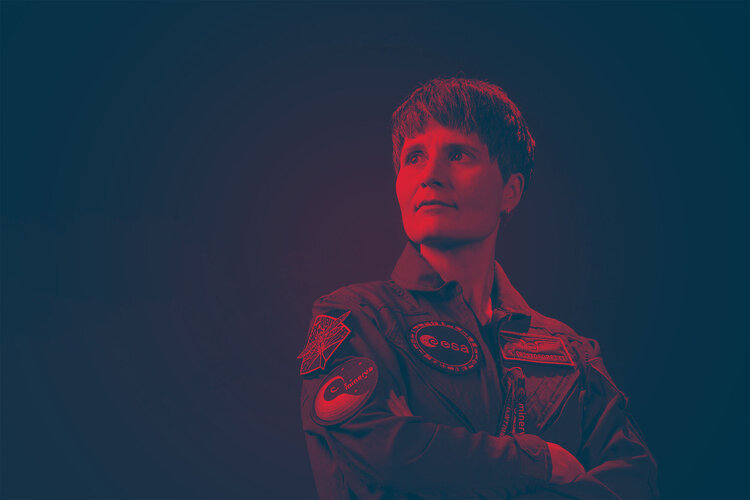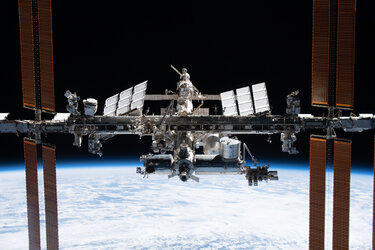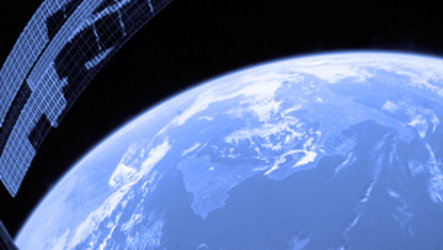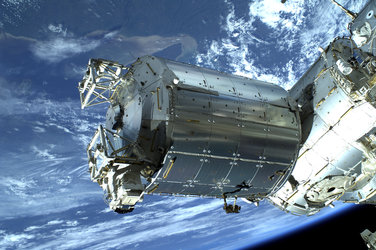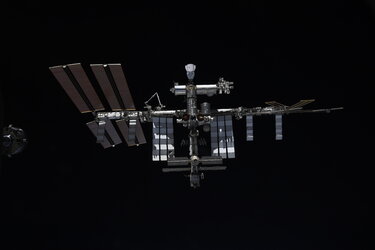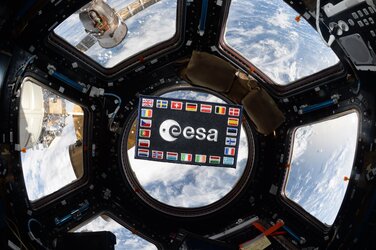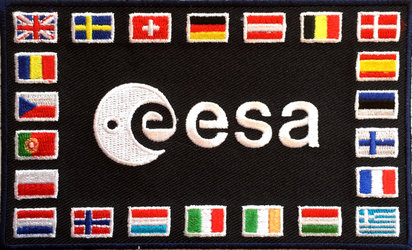ESA's International Space Station barter agreements
ESA Barter Agreements
ESA has engaged in a series of barter arrangements with other space agencies within the framework of the International Space Station (ISS) Programme. These arrangements formalise exchanges of goods and/or services with the other agencies without a corresponding financial transaction, i.e. without an exchange of funds. Different from cooperation schemes where partners provide complementing elements to a joint project, or fulfil obligations by contributions in kind, barter arrangements are characterised by the partners receiving goods or services from each other, which they would otherwise have to provide by themselves. For ESA, such barter arrangements avoid the need to make cash payments to non-Member States, and instead permit such budgets to be invested with European industry. Other advantages are the reduction of technical and financial risks (concerning the elements, which are provided by the other party), contribution to standardisation and commonality throughout the ISS Programme and the strengthening of the ISS cooperation and partnership. It is however to be recognised that barter arrangements by nature also introduce an element of dependence from the other party through the exposure to the programmatic risks (in particular schedule) related to the activities of the partner. For a barter arrangement to be attractive, it must be beneficial to both parties. Such benefit can be, for example, reduction of cost (e.g. compared to the cost which would result for a party if it would have to provide a bartered good or service by its own), or even access to goods and/or services, which would be otherwise out of reach for one party (e.g. the launch of Columbus Laboratory for ESA). Many barter arrangements are based on ESA delivering goods (hardware), while the other party is providing services or access opportunities to its ISS facilities. ESA has concluded ISS-related barter arrangements with Cooperating Agencies (NASA, Roscosmos, JAXA, CSA), and with ASI. The following paragraphs summarise these arrangements.
ESA/NASA Early Utilisation Opportunities of the ISS (18 March 1997)
The primary objective of this “Early Utilisation MOU” was to ensure that the European user community would gain early utilisation access to the Space Station, prior to the Columbus Laboratory’s availability in orbit. Through this barter agreement, ESA obtained:
Access to 50 % of the experiment module accommodation in a NASA payload rack in the US Laboratory for a period of 2 years. Use of this resource was covered by a cooperative research agreement between ESA and NASA, which was concluded on 28 September 1999 identifying ESA’s Material Science Laboratory (MSL) as the experiment module;
Accommodation of European provided research equipment in a US research facility or facilities for a period of 2 years. The research equipment to be accommodated was defined by a cooperative research agreement, concluded on 9 October 2001, as the European Modular Cultivation System (EMCS);
Use of one-half of one attached payload accommodation site on the Truss for a period of 3 years;
Two Space Shuttle flight opportunities for European astronauts prior to the on-orbit assembly of the Columbus Laboratory.
In exchange, ESA delivered the following “Laboratory Support Equipment” to NASA:
Microgravity Science Glovebox (MSG), 3 units of the Minus Eighty Degrees Laboratory Freezer (MELFI), the Hexapod Pointing System, and an adapted Columbus Mission Data Base (MDB) to be used as part of NASA’s ISS Ground Segment.
Apart from providing Europe the opportunity for early utilisation in predictable economic terms, the MOU avoids cash flow to the USA, and – for the case of MDB - allows a better exploitation of earlier investments made in Europe.
Since the signature of this MOU in March 1997 the following modifications have occurred:
NASA requested technical modifications to MSG and MELFI;
ESA and NASA considered in early 2001 on a technical level to attach the Early Utilisation external payloads no longer to the truss site, but on the Columbus External Payload Facility. This consideration was triggered by questions concerning the timely availability of the Express Pallet and associated adapters to be located on the truss sites as well as by payload interference problems.
ESA/NASA Super Guppy Transporter Barter Contract (15 August 1997)
This “Super Guppy Barter” originated from a NASA request for ESA to support their negotiations with Airbus Industry for the acquisition of a Super Guppy aircraft for ferrying large ISS elements between NASA centres. ESA made all arrangements with Airbus Industry, including the payment of an ESA-negotiated price, for the transfer to NASA of the aircraft plus associated equipment, spares and services. In return, NASA provided to ESA standard Shuttle services for a total of 450 kg ESA payload upmass on Shuttle flights. Thus, the arrangement allowed ESA to avoid cash payments to NASA for Shuttle transportation services by instead spending a fixed amount in Europe.
ESA/NASA Columbus Orbital Facility Launch Barter (8 October 1997)
The objective of the "Columbus Launch Barter" arrangement for ESA was to obtain the launch of the Columbus Laboratory and its initial payload on the Shuttle without transferring money to NASA. As compensation, the original arrangement foresaw ESA to provide to NASA the fully integrated Nodes 2 and 3, Cryogenic Freezer and Crew Refrigerator/Freezer equipment for ISS, spares and sustaining engineering for the Laboratory Support Equipment items provided by ESA to NASA under the “Early Utilisation MoU”, and hardware/software support for software development and integration in NASA ground facilities for ISS. Since the signature of that arrangement on October 8, 1997, two amendments have been concluded:
(1) “Protocol Amending the Arrangement between NASA and ESA Regarding Shuttle Launch of Columbus Orbital Facility and its Offset by ESA Provision of Goods and Services”, signed on 3 August 2000. The amendment reflects the NASA requested reengineering of Nodes 2 and 3 configuration to include functionalities previously covered by the US Habitation Module. In exchange, NASA took over the responsibility for the procurement of the US sourced outfitting hardware for Node 3 (originally an ESA responsibility). The resulting financial imbalance was accepted by ESA on the basis of having avoided the financial risk of procuring hardware in the US, taking into account indications that such procurement would significantly exceed NASA’s estimate. As a consequence, it was agreed between ESA and ASI to increase the overall financial allocation for the Node 2/3 project.
(2) “Amendment to the Arrangement between NASA and ESA regarding Shuttle Launch of Columbus Orbital Facility and its Offset by ESA Provision of Goods and Services (Amendment 2)”, signed on 22 July 2002. The amendment covers the implementation by ESA/ASI of further NASA directed modifications to the Nodes 2 and 3 requirements and scope of work. Costs of this implementation through ASI were negotiated between ESA and ASI. The principal compensation element of NASA for ESA/ASI’s implementation of the Nodes’ changes are savings to the benefit of ESA resulting from the cancellation of the Crew Refrigerator/Freezer development beyond the development and delivery of a single qualification unit. The original obligation of ESA was development and delivery of 9 flight units, 1 flight spare, training units and related GSE. To “fine-tune” this balance, ESA will implement a number of changes to the Cupola (being an ESA obligation in the frame of the “Cupola Barter”), while NASA will provide (a) a firm fixed credit to ESA to be applied against ESA’s financial obligations for Shuttle Mission Specialist Training, (b) 10 ISS lockers and 10 8-Panel Unit drawers, for accommodation in the ESA European Drawer Rack. Furthermore, formally outside this amendment, but within its overall balance, NASA agreed to cancel its financial claim on ESA, representing the net balance following modification of the “Cupola Barter”, where ESA has to deliver only one cupola instead of two as originally foreseen and on the basis of which the NASA obligations were established.
ESA/NASA MOU for Cooperation in the X-38 Project (8 July 1999)
Although not being a classical barter arrangement but rather an ESA/NASA cooperation, the MOU on the X-38 Project was regarded as a key precursor of a planned barter arrangement on the Crew Return Vehicle (CRV). The MOU was motivated by preliminary studies of ESA and NASA, which indicated areas in which performance and cost objectives for the prototype X-38 vehicle could be enhanced through incorporation of specific European design, system integration, and manufacturing capabilities. ESA contributions consisted of hardware, software and engineering expertise provided to NASA in particular for use on the space flight test vehicle V201 and to be integrated by NASA for orbital flight test. NASA’s responsibility was the integration of the European parts in the X-38 V201 vehicle, launch on the US Space Shuttle and giving ESA access to flight data. On 12 August 2002, NASA informed ESA about having terminated the X-38 programme and at the same time notified ESA – pursuant to Article 15 of the MOU – of its intention to terminate the MOU.
ESA/NASA Cupola Barter Agreement (3 August 2000)
The main elements of the original "Cupola Barter", which was negotiated between ESA and NASA in autumn 1998, were on the ESA side to deliver to NASA the ISS elements Cupola-1 and Cupola-2, with associated spares and sustaining engineering. Moreover, ESA committed to enhance the Columbus Laboratory payload support concerning thermal control and Ethernet connectivity. NASA agreed to provide ESA with Shuttle transportation services for five external European payloads, and to allocate to ESA 68 kg of additional launch mass on the Columbus Laboratory launch. The barter agreement allowed ESA to avoid cash payments to the USA for Shuttle transportation services and to avoid potential price uncertainties for such services. In September 1999, before this original agreement was signed by the parties, NASA formally directed ESA to delete the second Cupola flight model and implement a modified on-orbit mission as well as related design changes for the remaining Cupola-1. The principal terms of the final arrangement were nevertheless kept identical to the original one, with the exception of the reduction of the number of cupolas to be delivered by ESA from two to one. This implies that the arrangement still foresees NASA providing goods and services corresponding to ESA delivering two cupola flight units. ESA and NASA agreed to compensate for the net value of this imbalance outside the Cupola Agreement. In the meantime, this compensation was settled in the context of the Amendment 2 of the “Columbus Launch Barter”, signed by ESA and NASA on 22 July 2002.
ESA/Roscosmos Service Module DMS Agreement (1 March 1996)
This arrangement foresaw ESA providing the Roscosmos (formerly Russian Space Agency (RSA)) with the Data Management System (DMS-R) comprising flight equipment for the Russian Service Module “Zvezda” plus necessary ground model, support equipment and spares, whilst Russia provided ESA with two flight sets of the active part of the Docking System for ESA’s Automated Transfer Vehicle (ATV), including ground model, support equipment and spares. The cooperation set out in this arrangement enhances the operational efficiency of the Space Station whilst avoiding duplication of development activities. It allows ESA to benefit from Russian long-standing experience in space vehicle docking systems. The cost for ESA developing the docking system on its own would have been considerably higher than the cost for the DMS-R, which is the recurring cost of the DMS for the Columbus Laboratory and ATV, with Zvezda-specific adaptations.
ESA/NASDA MOU on Hardware Exchange for ISS Utilisation (5 November 1997)
In the spirit of increasing the commonality in utilisation support equipment whilst minimising the respective development and procurement costs, this MOU committed ESA to provide JAXA (formerly NASDA) with one MELFI Freezer identical to those developed by ESA for NASA in the context of the Early Utilisation MOU. In compensation, JAXA provided ESA with 12 International Standard Payload Racks (ISPR) flight units for use on the ISS. This arrangement permitted ESA to avoid purchasing the ISPRs in the USA or Japan, and at the same time to better exploit the investments made in Europe for the development of MELFI for NASA.
ESA/CSA FSL and MVIS Cooperation (6 February 2001)
The agreement foresaw the upgrading of ESA’s Fluid Science Laboratory (FSL) by incorporating the Canadian provided Microgravity Vibration Isolation System (MVIS). MVIS reduces microgravity disturbances to the FSL and thus improved conditions for scientific experiments conducted in FSL. In exchange for MVIS, ESA provided to CSA access to the FSL for an amount of 5 % of the total time of ESA FSL use (necessary resources for the Canadian use are provided from CSA’s allocation as per the NASA-CSA ISS MOU).
ESA/ASI MPLM and Columbus Common Features Exploitation Arrangement (17 April 1997)
In the spirit of exploiting common features of the ASI-developed Multi-Purpose Logistics Module (MPLM) and ESA’s Columbus Laboratory, this arrangement committed ESA to provide ASI with the Environmental Control and Life Support System (ECLSS) for the MPLM, which is an adaptation of the ECLSS for the Columbus Laboratory, whilst ASI provided ESA with the primary structure of the Columbus Laboratory (derived from MPLM). Besides significant cost benefits (no full development of Columbus primary structure; ECLSS manufacturing basically at recurrent cost), this arrangement provided stronger commonality and standardisation within the ISS programme.
ESA Additional Flight Opportunities
In May 2001, ESA and the then Russian Aviation and Space Agency (Rosaviakosmos), now Roscosmos, signed a Framework Agreement for the provision of Russian ISS flight opportunities. The Agreement documents the principles, terms and conditions for the cooperation between ESA and Roscosmos concerning ISS operations and utilisation, through the provision by the latter of fare-paying ISS flight opportunities in the period 2001-2006, for members of the European Astronaut Corps. The actual commitment for a specific flight opportunity is entered by ESA upon signature of an ISS Flight Order Contract (IFOC) for a specific flight.
The Framework Agreement marks a milestone in the longstanding and increasing cooperation between ESA and Roscosmos. It establishes a solid and stable basis for the strategic planning of the European Astronaut Corps, and it represents an important step towards the further development of operational expertise of the ESA astronauts prior to the full European utilisation of the ISS with the launch of Columbus.
Two types of flight opportunities are considered under the Agreement as ISS flight opportunities:
ISS “taxi flights” (this term is reported in the original agreement, but is no longer used), which are defined as short duration Soyuz flights to the ISS for the purpose of exchanging the ISS docked Soyuz, including a short duration stay (approximately 7-8 days) on-board the ISS;
ISS increment flights, which are defined as ISS crew exchange flights, including a 3-6 months (one increment) stay on-board the ISS.
The assignment of ESA astronauts to a specific flight is subject to the approved ISS procedures, pursuant to the provisions of the IGA and ISS MOUs and other applicable ISS documents. Since all flight opportunities covered by the Agreement are flights to the ISS, ESA and Roscosmos ensure that relevant rules and regulations pertaining to the ISS and the space transportation vehicle are applied to all activities related to these flight opportunities. These rules and regulations include the Code of Conduct for the International Space Station Crew (CCOC) and the related Disciplinary Policy.
The assignment of back-up astronauts/cosmonauts for ISS flight opportunities, involving ESA astronauts, is agreed upon between ESA and Roscosmos for each flight.
On-board activities are not restricted to the mandatory system operations and maintenance activities, but also allow for the conduct of activities or experimental programmes in the interest of ESA and national organisations of the ESA Member States. The terms and conditions of such activities are agreed upon in each specific IFOC. The IFOC defines the terms and conditions specific to the implementation of an agreed ISS flight opportunity. Such terms and conditions takeprecedence over the terms and conditions defined in the Framework Agreement.
The ISS flight opportunities under the Agreement are implemented according to the following procedure:
Roscosmos, on a priority basis, notifies ESA in writing of an available ISS flight opportunity for the position of flight engineer in increment and visiting crew, identifying, inter alia, its technical, financial and programmatic elements;
Upon receipt of the Roscosmos notification of the availability of specific ISS flight opportunities, but in any case not later than four weeks thereafter, ESA expresses in writing to Roscosmos its acceptance or rejection for such a specific ISS flight opportunity based on the technical, financial and programmatic elements specified in the Roscosmos notification. In case of an ESA acceptance Roscosmos and ESA discuss all relevant details with the aim to agree on the provision of the specific ISS flight opportunity. In case of ESA not being in a position to fully accept the elements of the Roscosmos notification, then Roscosmos are entitled to negotiate this flight opportunity with other customers;
A commitment for an agreed ISS flight opportunity is entered into, following the signature by Roscosmos and ESA of a specific ISS Flight Order Contract (IFOC) which defines the specific contractual, financial, technical and management aspects of the agreed ISS flight opportunity, complementary to the principles, terms and conditions set forth in the Agreement. The respective responsibilities of the parties, related to the implementation of the ISS flight opportunities covered by the Agreement, becomes operative upon signature of the corresponding IFOC;
Roscosmos also, on a non-exclusive basis, notifies ESA in writing of available ISS flight opportunities for the position of flight researchers identifying, inter alia, its technical, financial and programmatic elements.















 Germany
Germany
 Austria
Austria
 Belgium
Belgium
 Denmark
Denmark
 Spain
Spain
 Estonia
Estonia
 Finland
Finland
 France
France
 Greece
Greece
 Hungary
Hungary
 Ireland
Ireland
 Italy
Italy
 Luxembourg
Luxembourg
 Norway
Norway
 The Netherlands
The Netherlands
 Poland
Poland
 Portugal
Portugal
 Czechia
Czechia
 Romania
Romania
 United Kingdom
United Kingdom
 Slovenia
Slovenia
 Sweden
Sweden
 Switzerland
Switzerland



























